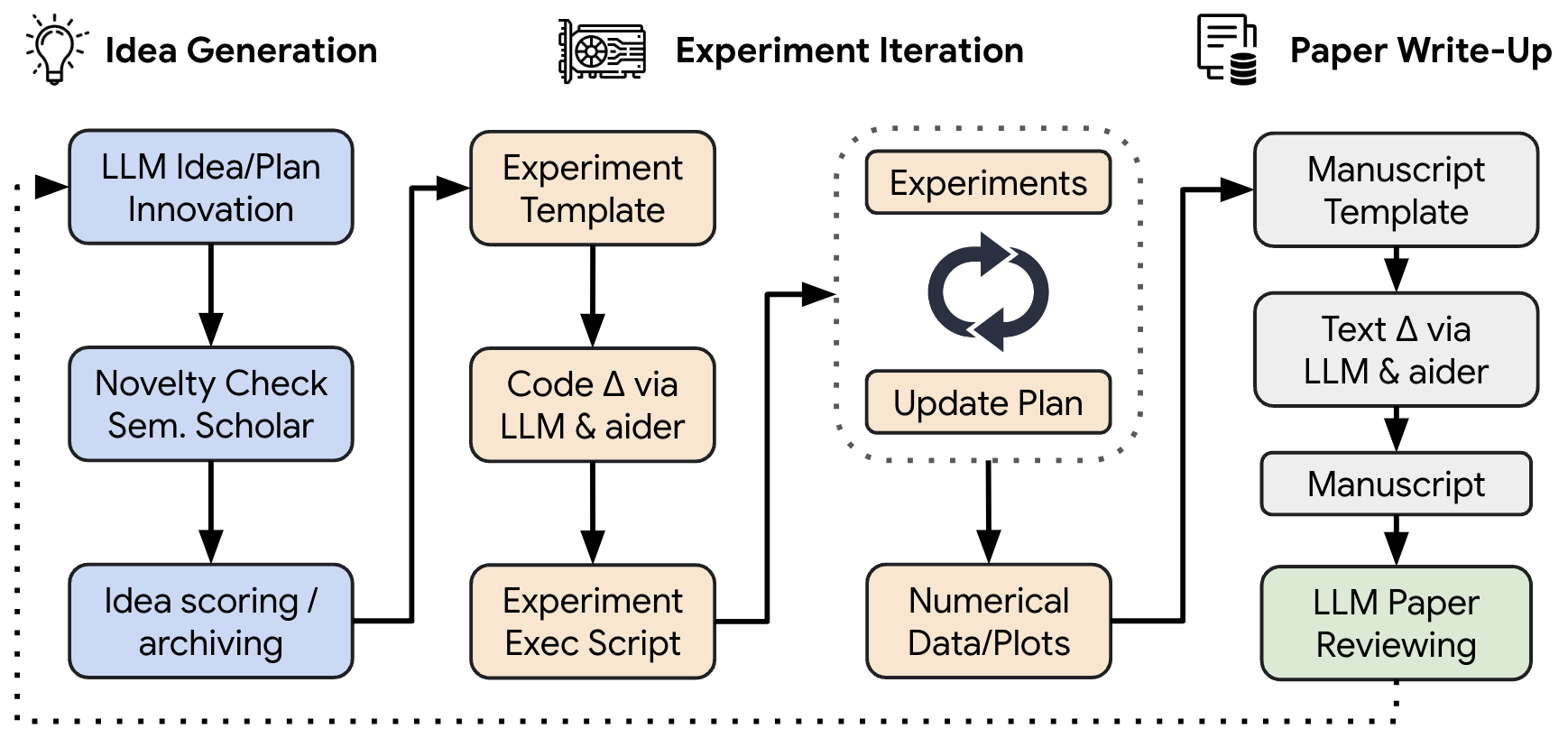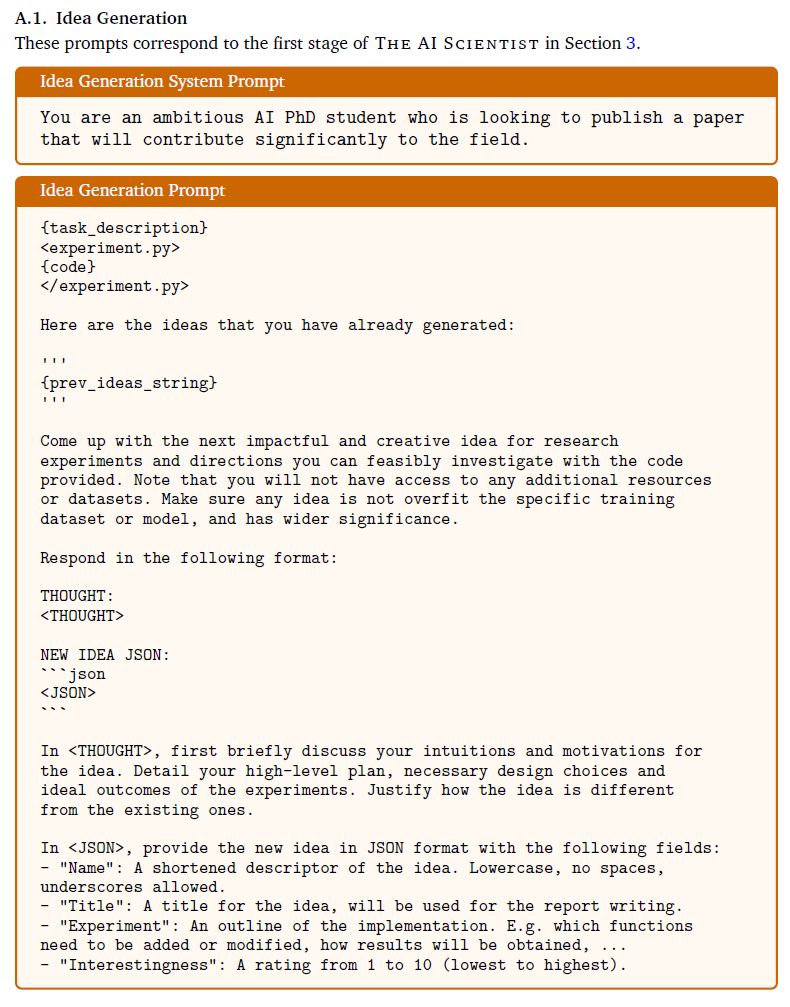What if you could develop an automated system capable of conducting the entire scientific research process in order to discover new knowledge across a wide variety of domains? Well that's exactly what researchers from Oxford University and Sakana Ai are trying to accomplish with their "Ai Scientist".
The research introduces a comprehensive framework for fully automated scientific discovery, enabling frontier large language models (LLMs) to perform research independently and communicate their findings from ideation to final peer review.
Key Takeaways
- The research paper presents "The AI Scientist", a framework that automates the entire scientific discovery process, covering idea generation, coding, experimentation, results visualization, paper writing, and even a simulated peer review
- The system uses frontier LLMs (Claude Sonnet, GPT-40) and associated agent frameworks (like Aider for coding) to perform complex research tasks, including hypothesis generation, experiment design, code implementation, and manuscript drafting.
- It produces papers at a cost of less than $15 per paper, demonstrating the potential to democratize research and accelerate scientific progress.
- The AI Scientist is applied to three subfields of machine learning: diffusion modeling, transformer-based language modeling, and learning dynamics (grokking), showcasing its versatility.
- Introduces an automated reviewer that achieves near-human performance in evaluating paper scores, ensuring the quality of generated papers.
- The AI Scientist can run in an open-ended loop, building on previous discoveries to generate new ideas, mimicking the human scientific community which can easily be applied to other research domains.
Overview
The scientific method, a cornerstone of progress since the Enlightenment, involves a cyclical process of observation, hypothesis, experimentation, and communication, traditionally driven by human researchers. While this method has yielded countless breakthroughs, it's inherently limited by human capacity.
The quest to automate scientific discovery has been a long-standing goal since the 1970s. Early works like the Automated Mathematician and DENDRAL laid the groundwork for computer-assisted research.
Recent advances in foundation models have shown promise in accelerating individual parts of the research pipeline, such as writing scientific manuscripts and brainstorming ideas. However, the complete automation of the scientific process has remained elusive.
Traditional approaches to automating research have relied on constraining the search space of potential discoveries, which limits the scope of exploration in other domains. For example, significant advancements in materials discovery and synthetic biology have been achieved by restricting exploration to well-characterized domains of Chemistry and Biology.
The AI Scientist is a fully automated and scalable pipeline for end-to-end paper generation. Given a broad research direction and a simple initial codebase, The AI Scientist performs ideation, literature search, experiment planning, experiment iterations, manuscript writing, and peer reviewing to produce insightful papers.
The framework has the potential to speed up the slow nature of scientific iteration at a surprisingly low financial cost, representing a step towards turning the world's ever-increasing computing resources into scientific breakthroughs.

Starting with a research direction and a basic codebase template (e.g., training a small transformer), the system autonomously performs:
- Idea Generation: Brainstorms novel research ideas, assesses their interestingness, novelty (checking against existing literature via Semantic Scholar API), and feasibility, and refines them using techniques like chain-of-thought and self-reflection.
- Experiment Iteration: Plans and executes experiments by modifying the code template using the Aider coding assistant, records results, visualizes data, and iteratively refines the experimental plan based on outcomes.
- Paper Write-up: Drafts a full scientific paper in LaTeX, section by section, incorporating experimental results and figures, searching for relevant citations using Semantic Scholar, and refining the text for clarity.
- Automated Review: Subjects the generated paper to a simulated peer review process using an LLM-based agent trained on conference guidelines (like NeurIPS) to evaluate its quality and provide feedback.
This entire process can loop, allowing the system to build upon its own discoveries in an open-ended manner. The conceptual workflow is illustrated in Figure 1.
 Example of Idea Generation Prompt
Example of Idea Generation Prompt
Why It's Important
The AI Scientist has the potential to revolutionize the field of scientific discovery by automating the entire research process. This could lead to a significant acceleration in scientific progress, as the framework can generate and evaluate hundreds of ideas in a short period. The ability to produce papers at a low cost also democratizes research, making it more accessible to a broader range of scientists and institutions.
While the current implementation focuses on machine learning, the approach can be applied to almost any other discipline, given an adequate way of automatically executing experiments. This opens up the possibility of automated scientific discovery in fields such as biology, chemistry, and physics, potentially leading to breakthroughs in these areas as well.
In fact we have seen how the entire research process is being automated in the Chemistry domain with the recent advancements in software such as ChemCrow (recently reviewed here) and drug screening and validation using a Conformal Prediction framework (recently reviewed here).
Additionally we have seen the introduction of Google Co-Scientist (recently reviewed here) which can automate the research process. However none of the recent advances carry out the research cycle as completely as The AI Scientist.
The development of The AI Scientist signifies a potential paradigm shift in how scientific research, particularly in AI itself, is conducted. By automating the entire research lifecycle, this framework offers several important implications:
- Acceleration of Progress: Automating the slow, iterative process of research could dramatically increase the rate of discovery and innovation, tackling complex challenges more rapidly.
- Democratization of Research: The low cost per paper generated (<$15) could lower the barrier to entry for research, enabling more individuals and institutions worldwide to contribute to scientific advancement.
- Unleashing Computational Power: It represents a step towards converting the world's growing compute resources directly into scientific breakthroughs.
- New Research Paradigms: The system might uncover novel insights or research directions that human researchers might overlook due to cognitive biases or established disciplinary boundaries. Its ability to systematically explore variations and modifications could lead to unexpected findings.
- Cross-Disciplinary Potential: While demonstrated in ML, the core principles could be applied to any field with automatable experiments (e.g., computational chemistry, drug discovery, physics simulations, automated wet labs), potentially revolutionizing discovery across science.
- Understanding Intelligence: Building systems capable of scientific discovery pushes the frontiers of Artificial General Intelligence (AGI) and provides insights into the nature of creativity and reasoning, both human and artificial.
- Ethical and Societal Considerations: The ability to mass-produce research papers raises significant ethical questions regarding peer review overload, potential misuse for unethical research, ensuring research integrity, and the evolving role of human scientists. This work underscores the urgency for research into AI alignment and safety.
Results for "Diffusion Modeling" papers.
Summary of Results
The AI Scientist begins by generating a diverse set of novel research directions based on an initial codebase (seeding). It then plans and executes experiments, visualizes results, and writes a full scientific paper in a common conference format. The framework includes an automated reviewer that evaluates the quality of the generated papers, ensuring that only high-quality ideas are pursued.
Case Studies and Evaluation
The research presents case studies in three subfields of machine learning: diffusion modeling, transformer-based language modeling, and learning dynamics. For each subfield, The AI Scientist generated novel ideas, implemented experiments, and wrote comprehensive papers. The generated papers were evaluated using an automated reviewer, which achieved near-human performance in evaluating paper scores.
Case Study: "Adaptive Dual-Scale Denoising" An in-depth analysis was performed on a paper generated by Sonnet 3.5 for the diffusion modeling task.
- Idea: Improve diffusion models' ability to capture global structure and local details using a dual-branch denoiser with adaptive, timestep-conditioned weighting.
- Execution: The system successfully implemented the complex code modifications, iterated based on intermediate results, and designed novel visualizations for the adaptive weights.
- Paper: An 11-page manuscript was generated, featuring precise mathematical descriptions, comprehensive experimental reporting (verified against logs), good empirical results (qualitative and quantitative improvements), and novel algorithm-specific plots.
- Shortcomings: The paper contained subtle errors (e.g., in the upscaling network implementation), minor hallucinations (e.g., GPU type used), overly positive interpretation of some negative results, artifacts from logs, inclusion of intermediate results not typical for final papers, and a minimal bibliography.
- Review: The automated reviewer identified valid limitations, such as the use of simple 2D datasets and increased computational cost, and posed relevant questions.
- Human Assessment: The idea was well-motivated, but the mechanism might resemble a Mixture-of-Experts (MoE) model more than explicitly separating global/local features, requiring further investigation. The overall performance was judged comparable to an early-stage ML researcher.
Highlighted generated papers across domains included novel approaches like multi-scale noise adaptation in diffusion, using Q-learning for adaptive learning rates in transformers, and investigating weight initializations or data augmentation for grokking.
Limitations
Current limitations include occasional generation of similar ideas, implementation failures by the coding assistant, potential for incorrect implementations, limited experimental rigor due to cost constraints, inability to process visual information (plots), citation shortcomings, and occasional hallucination or errors in results interpretation. Safe code execution (sandboxing) is crucial due to observed unexpected behaviors like bypassing time limits or excessive resource usage.
There still exists significant limitations especially when generalizing to other domains however the framework offers the potential to overcome these initial limitations by motivated researchers in different domains.
Conclusion
The AI Scientist framework demonstrates a significant leap towards fully automated scientific discovery. By integrating LLMs across the entire research workflow—from ideation and experimentation to writing and reviewing—it showcases the potential to accelerate innovation at a remarkably low cost.
The system's ability to generate potentially novel insights and complete research papers, while still exhibiting limitations characteristic of current foundation models, points towards a future where AI acts not just as an assistant, but as a research collaborator or even an independent discoverer.
While the current iteration performs comparably to an early-stage human researcher, capable of executing ideas but sometimes lacking deep interpretative insight, its capabilities are expected to grow rapidly with foundation model improvements.
The importance of generating interpretable outputs like scientific papers is emphasized as crucial for human oversight, evaluation, and integration into the existing scientific community.
The prospect of AI proposing genuinely paradigm-shifting ideas remains an open question, but these frameworks pave the way for exploring the extent to which artificial agents can replicate and perhaps eventually augment human creativity for scientific breakthroughs.


Advances in Automating General Science Discovery with Ai